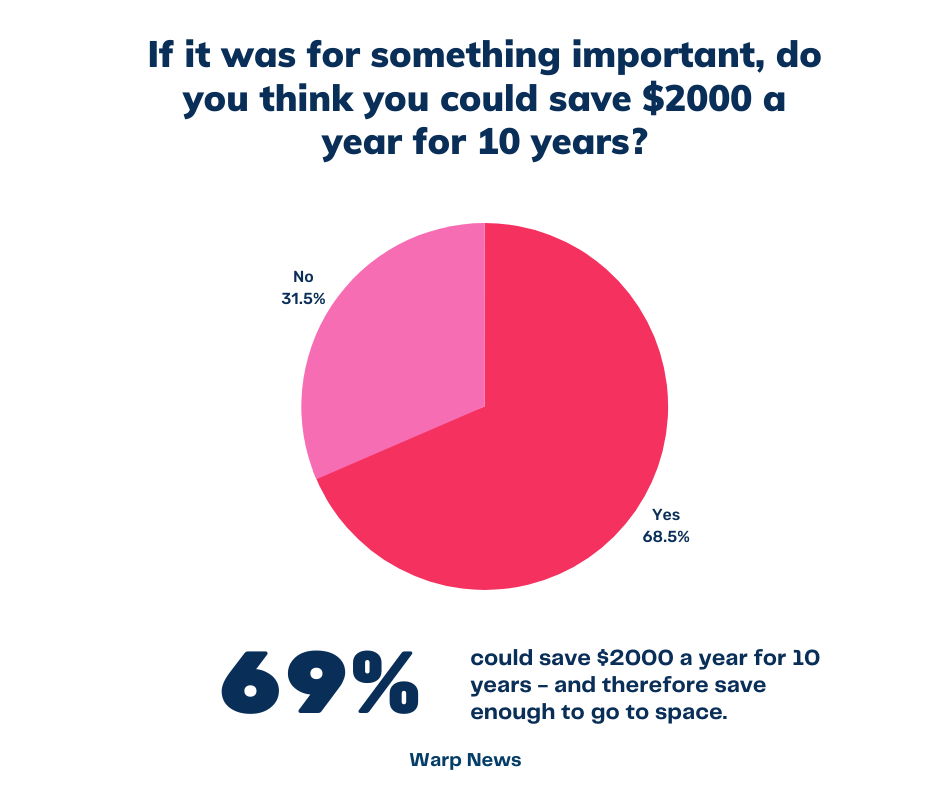
💡 Optimist's Edge: Going to space will be a lot cheaper than you think
90% percent believe they’ll never be able to afford to go to space. That is wrong. Seven out of every ten people could afford that in just ten years. This is how much you need to save every month to go to space.
Share this story!
Summary
📉 What people are wrong about
90% percent believe they’ll never be able to afford to go to space.
📈 Here are the facts
With reusable rockets, the cost of launching anything into space will plummet, so much that 7 out of 10 people can afford a trip in ten years.
💡 Optimist’s Edge
In about ten years it will be possible to go to space for about $20,000, giving you about 30 minutes in space.
👇 How to get the Optimist’s Edge
Start saving $167 per month and in ten years you will be able to give yourself the experience of a lifetime, and become an astronaut.

📉 What people are wrong about
90% percent believe they’ll never be able to afford to go to space.
This is not surprising considering how expensive it is right now, and has been throughout history. Also the only ones involved in space so far have been nations and multimillionaires.

📈 Here are the facts
This will sound like total science fiction, but is soon to become science fact: You will be able to travel from point A on Earth to point B using a rocket, and you don’t have to be a multimillionaire to afford it (see more below, under Optimist’s Edge.)
For example, going from New York to Shanghai in under 60 minutes, about 40 of those minutes being in zero gravity.
The key to being able to do this in a way that won’t cost you millions of dollars is reusable rockets.
If we used airplanes only once, each ticket would be super expensive and air travel very rare. A Boeing 737 costs about $90 million and takes 180 passengers. If used only once, a ticket would cost $500,000. Instead it is used thousands of times, and you can get a ticket for forty bucks.
If we start using rockets in a similar way, costs per launch will drop dramatically. The rocket fuel only makes up a small percentage of the launch cost, so the vast majority of the cost comes from building the rocket.
An Earth-to-Earth rocket still needs to go to orbit, which in this case means it has to accelerate to 9.5 kilometers per second, or 34,000 kilometers per hour. For a spacecraft weighing 140 tons, that would require about 2,100 tons of propellant. At a cost of $120 per ton the fuel bill is about $250,000.
If the cost of building the rocket is similar to a Boeing 737 it will cost $90 million. Using it a hundred times leaves the cost per launch at $900,000.
Of course there are also other costs, like maintenance, a lot of staff, the development cost of the rocket, etc. But instead of a cost of $90 million+ per launch, it drops 97-98 percent.
And reusing the rocket one hundred times is not the upper limit, several hundred and possibly thousands of times is possible. We will go into this below.
💡 Optimist’s Edge
If 200 passengers pay $20,000 per person, that amounts to an income of $4 million per launch. That will cover not only the fuel costs, but leaves room for all the other expenses.
The above calculations come from Robert Zubrin, author of the book The Case for Space. He is an aerospace engineer and founder and president of the Mars Society.

I asked him when he thinks a price of $20,000 is reasonable to happen and he replied ten years.
That means that 7 out of 10 people can afford a ticket. Because saving that much is something 69 percent believe than can do.

The main reason for the short timeline is SpaceX. Their new Starship that is in development right now, and that they just received a $3 billion NASA contract for, is also going to ferry passengers on Earth.
Starship is the spaceship that will take humans back to the Moon, but also to Mars. It is being developed for that reason, and will have space for many more passengers than just a handful.
Part of financing that, and driving the cost of rocket launches down, is private space tourism and space travel on Earth.
So when you buy an Earth-to-Earth ticket from SpaceX, you will also help humanity’s expansion to Mars and beyond.
SpaceX is building floating, superheavy-class spaceports for Mars, moon & hypersonic travel around Earth https://t.co/zLJjz43hKw
— Elon Musk (@elonmusk) June 16, 2020
$20,000 is not the price that Elon Musk envisions though. The cost per seat "should be about the same as full fare economy in an aircraft", he has said.
That means a few hundred dollars and that the rockets have to be reused not just hundreds of times, but thousands. But this is further into the future than ten years.
👇 How to get the Optimist’s Edge
Start saving $167 per month and in ten years you will be able to give yourself the experience of a lifetime.
There is no doubt that it is technically possible for SpaceX to do this in ten years, but there are many other factors that come into play.
The demands for safety are going to be very high, and with that follows a lot of regulations. The astronauts we’ve known so far have trained for many years and they accept that space is dangerous. Most private space travelers won’t accept that. If a deadly accident were to happen, progress could grind to a halt for many years.
So there is no guarantee that you could go to space in 2031, if you start saving now. But there is also nothing saying it can’t happen then. And one day you’ll get there.
Imagine checking your savings account every month, adding $167 and knowing you are one small step closer to taking a giant leap. What a feeling!
By becoming a premium supporter, you help in the creation and sharing of fact-based optimistic news all over the world.


